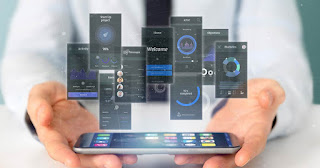How Wearable Tech is Changing Enterprise App Development?
The ubiquity of mobile computing devices like smartphones and tablets has made mobile apps a crucial component. Consequently, the demand for app development has surged in recent years. As every new high-end device relies on mobile apps, the supply and demand for Enterprise mobility solutions have reached an all-time high. With no indication that technological progress will slow down, app developers strive to exploit this trend.
A wearable application development company has shattered the misconception that wearable technology in enterprise apps is limited to smartwatches. Many businesses can use wearables to fulfill operational requirements and enhance productivity by creating corporate apps. Businesses can greatly increase their productivity and effectiveness by providing employees with timely access to relevant information.
Let's explore some practical use cases for wearables and examine how they impact consumer demand:
How can wearable technologies be used in a mobile business strategy?
It is speculative how wearable technology applications may affect the development of specific workplace mobility strategies because most organizations are currently lagging behind app development for smartphones and tablets. Employees' adoption of wearable technology will depend on the usefulness of the apps that businesses offer. Applications must directly help users to improve and streamline other employees' work.
When developing an app for safety glasses that enables construction workers to view plans and schematics, businesses could include a feature that allows users to play music on the device. While wearable design technology may take some time to gain widespread adoption, enterprise IT must be willing to take a chance on various apps that cost little to nothing upfront. Businesses must be prepared to respond quickly, as the release cycle for enterprise apps is generally three months.
How to Use Wearables: Overcoming Fragmentation for Corporate Adoption"
For wearable technology to gain widespread adoption in the corporate world, manufacturers must address the significant issue of fragmentation caused by developing products on separate, company-specific platforms.
However, the high cost and complexity of developing cross-platform software for multiple operating systems is deterring developers from pursuing technical improvements due to the lack of standardization. To effectively integrate wearable devices and simplify app development, a solution is needed that can compete with Android, Windows, or iOS.
Secondly, both businesses and employees have valid concerns about the security of wearable technology. Wearable technology increases IT complexity from a company standpoint and raises concerns about data leakage and employee device eavesdropping. The question of whether wearable technology complies with HIPAA regulations in the healthcare industry is also a consideration. Wearable technology may eventually be used in Big-Brother-style surveillance systems to monitor employees' every move on the employee side.
Last but not least, pricing greatly hinders the adoption of wearable technology at the consumer and commercial levels. Wearable app development won't take off in this sector unless wearable technology becomes profitable. The Google Glass device, currently in beta testing, costs $1,500, making it financially limited for many companies to furnish notable parts of their personnel.
Discover the various ways in which wearable technology is set to dominate.
Smartphones are taking over.
Smartphone usage in the workplace is quite prevalent. Cellphones are not trustworthy or suitable for the purpose; thus, wearable technologies can show that they are utilized in ways that cell phones cannot. At this early stage of their development, wearables only act as smartphone accessories. However, portability and hands-free use are the main advantages enabling it to surpass smartphones in intelligence.
Real-world implementations
Wearable technology is predicted to have a big influence on several businesses. When discussing healthcare, we notice that wearables are used as surgeons perform the procedure while being observed uninterrupted. Since smart glasses enable technicians working off-site to feed video in real-time, wearables are being used more frequently in the industrial sector.
Enterprise Mobility Strategy and Wearables
Whether to incorporate Wearables in the corporate mobility plan has yet to be determined since the wearables enterprise mobility app development team is currently implementing telephones. The corporate app development team will concentrate on streamlining and enhancing employee responsibilities. Apps with low development costs will be more advantageous to businesses.
Wearable technology barriers
Businesses will only begin utilizing this emerging technology once the manufacturers address the issues with creating corporate apps. Wearable technology has a major obstacle in the form of fragmentation. The developers will face challenges in advancing technology as they construct apps for corporate mobility development technology with the next-gen through various platforms and devices. Therefore, there are costs associated, and the apps are challenging.
Various Types of Wearables
Smartwatches and fitness/wellness trackers dominate the wearables industry.
Internet of Things(IoT)
These linked gadgets are based on the Internet of Things (IoT). It links gadgets and promotes data interchange to determine logical results for smart living. Connectivity is the key component of wearables that drives their initial sales, not just one more IoT subfield. A collection of IoT use cases in healthcare provides a glimpse into the technology's future.
Retail customers are a target market for items like iWatch, smart lenses, etc., from Google and Apple. In addition to the Galaxy wristwatch, Samsung now offers IoT solutions in wearables for fleet management and monitoring. Wearables are closely related to the future of IoT and will continue to influence app development for end users. Wearable app makers should include IoT to stand out in the market.
Customized features for apps
Due to the lower cost of their memory and hardware compared to smartphones, wearable apps require fewer resources. Consider the wristwatch app as an example. Unlike general smartphone applications, which various ancillary functions might overrun, the smartwatch will focus solely on showing time.
Data Ownership
The Internet of Everything has replaced the Internet of Things in popular culture. IoT devices will number 31 billion, according to studies. They will produce 79 zettabytes' worth of data when combined.
Devices that use wearable technology, such as body-mounted gear, smart eyewear, and fitness trackers, provide data that allows hardware and software companies to map user profiles. The connection of wearable technology firms with e-retail & digital marketplace platforms will be made possible by shared data ownership.
Evolution of smartwatches
Consumer psychology tends to move quickly. For a much lower cost, smartwatches offer a comprehensive experience similar to that of smartphones. In addition to serving as an alternative to smartphones and fitness trackers, smartwatches have many other uses. They can rapidly receive notifications from social media at a time when speedy interactions are the norm. Some wearable technology includes YouTube support as well. With a wristwatch, those concerned about their health may keep track of their sleep, glucose level, calories burnt, stress levels, and more. So the next big thing is expected to be enabling wristwatch interface interaction with home devices and gadgets.
Wrapping up
Given all of that, it is crucial for an app developer, particularly one creating wearable technology, to be ahead of the curve and quickly respond to the most recent hype train circling the industry. It's difficult to keep programs current and effective in a way that pleases all concerned hardware parties, yet doing so is what distinguishes strong apps from merely OK or even awful apps.
The cost is another aspect that is taken into account. Said the expense of wearable technology needs to be supported. One of the greatest firms for developing mobile apps is Teksun, which also develops wearable apps. We have seen great growth in just two years and added a sizable high-skilled team. We believe in developing creative apps for our valued customers.
Discover how the rise of wearable technology is transforming enterprise app development and the new opportunities and challenges it presents for businesses.



Comments
Post a Comment